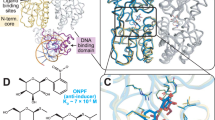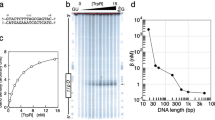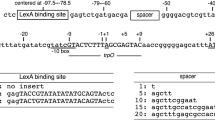Abstract
A sequence of about fifty amino-acids at the N-terminus of the lac repressor is thought to bind directly to lac operator DNA. Although this length cannot make the conventional cleft, it could form a protrusion; the manner in which such a protrusion interacts with the DNA site is discussed here.
This is a preview of subscription content, access via your institution
Access options
Subscribe to this journal
Receive 51 print issues and online access
$199.00 per year
only $3.90 per issue
Buy this article
- Purchase on Springer Link
- Instant access to full article PDF
Prices may be subject to local taxes which are calculated during checkout
Similar content being viewed by others
References
Gilbert, W., and Müller-Hill, B., Proc. US Nat. Acad. Sci., 58, 2415 (1967).
Riggs, A. D., Suzuki, H., and Bourgeois, S., J. Mol. biol., 48, 67 (1970).
Müller-Hill, B., Beyreuther, K., and Gilbert, W., Methods in Enzymology, 21, part D, 483 (edit. by Grossman, L., and Moldave, K., 1971).
Willson, C., Perrin, D., Cohn, M., Jacob, F., and Monod, J., J. Mol. Biol., 8, 582 (1964).
Davies, J., and Jacob, F., J. Mol. Biol., 36, 413 (1968).
Müller-Hill, B., Crapo, L., and Gilbert, W., Proc. US Nat. Acad. Sci., 59, 1259 (1968).
Müller-Hill, B., Angewandte Chemie (int. edit.), 10, 160 (1971).
Miller, J. H., Beckwith, J. R., and Müller-Hill, B., Nature, 220, 1287 (1968).
Pfahl, M., thesis, Cologne (1971).
Gronenborn, B., Diplomarbeit, Cologne (1971).
Miller, J. H., The Lactose Operon (edit. by Beckwith, J. R., and Zipser, D.), 173 (Cold Spring Harbor Laboratory, 1970).
Perutz, M. F., Nature, 228, 726 (1970).
Platt, T., Miller, J. H., and Weber, K., Nature, 228, 1154 (1970).
Goldschmidt, R., Nature, 228, 1151 (1970).
Platt, T., Weber, K., Ganem, D., and Miller, J. H., Proc. US Nat. Acad. Sci., 69, 897 (1972).
Crick, F., Nature, 234, 25 (1971).
Watson, J. D., and Crick, F. H. C., Nature, 171, 737–964 (1953).
Pauling, L., Corey, R. S., and Branson, H. R., Proc. US Nat. Acad. Sci., 37, 205 (1951).
Sung, M. T., and Dixon, G. H., Proc. US Nat. Acad. Sci., 67, 1616 (1970).
Schiffer, M., and Edmundson, A. E., Biophys. J., 7, 121 (1967).
Riggs, A. D., Bourgeois, S., and Cohn, M. J., J. Mol. Biol., 53, 401 (1970).
Lin, S.-Y., and Riggs, A. D., Nature, 228, 1184 (1970).
Sadler, J. R., and Smith, T. F., J. Mol. Biol., 62, 139 (1971).
Author information
Authors and Affiliations
Rights and permissions
About this article
Cite this article
ADLER, K., BEYREUTHER, K., FANNING, E. et al. How lac Repressor Binds to DNA. Nature 237, 322–327 (1972). https://doi.org/10.1038/237322a0
Received:
Issue Date:
DOI: https://doi.org/10.1038/237322a0
This article is cited by
-
Ligand-specific changes in conformational flexibility mediate long-range allostery in the lac repressor
Nature Communications (2023)
-
Genetic analysis of uxuR and exuR genes: evidence for ExuR and UxuR monomer repressors interactions
Molecular and General Genetics MGG (1985)
Comments
By submitting a comment you agree to abide by our Terms and Community Guidelines. If you find something abusive or that does not comply with our terms or guidelines please flag it as inappropriate.



